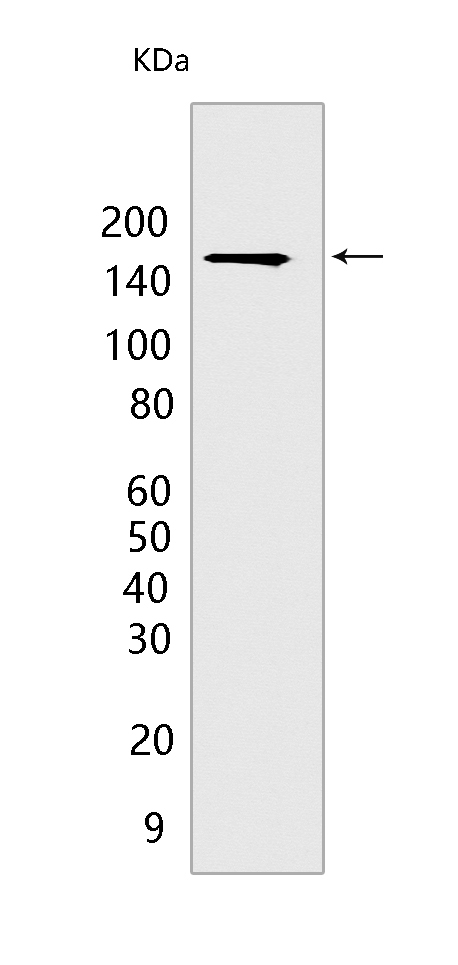DIAPH1 Rabbit mAb [271U]Cat NO.: A61320
Western blot(SDS PAGE) analysis of extracts from HCT 116 CELLS .Using DIAPH1Rabbit mAb [271U] at dilution of 1:1000 incubated at 4℃ over night.
Product information
Protein names :DIAPH1,DIAP1,DIAP1_HUMAN,Protein diaphanous homolog 1
UniProtID :O60610
MASS(da) :141,347
MW(kDa) :155 kDa
Form :Liquid
Purification :Protein A purification
Host :Rabbit
Isotype :IgG
sensitivity :Endogenous
Reactivity :Human,Mouse,Rat
- ApplicationDilution
- 免疫印迹(WB)1:1000-2000
- 免疫组化(IHC)1:100
- The optimal dilutions should be determined by the end user
Specificity :Antibody is produced by immunizing animals with a synthetic peptide at the sequence of human DIAPH1
Storage :Antibody store in 10 mM PBS, 0.5mg/ml BSA, 50% glycerol. Shipped at 4°C. Store at-20°C or -80°C. Products are valid for one natural year of receipt.Avoid repeated freeze / thaw cycles.
WB Positive detected :HCT 116 CELLS
Function : Actin nucleation and elongation factor required for the assembly of F-actin structures, such as actin cables and stress fibers (By similarity). Binds to the barbed end of the actin filament and slows down actin polymerization and depolymerization (By similarity). Required for cytokinesis, and transcriptional activation of the serum response factor (By similarity). DFR proteins couple Rho and Src tyrosine kinase during signaling and the regulation of actin dynamics (By similarity). Functions as a scaffold protein for MAPRE1 and APC to stabilize microtubules and promote cell migration (By similarity). Has neurite outgrowth promoting activity. Acts in a Rho-dependent manner to recruit PFY1 to the membrane (By similarity). In hear cells, it may play a role in the regulation of actin polymerization in hair cells (PubMed:20937854, PubMed:21834987, PubMed:26912466). The MEMO1-RHOA-DIAPH1 signaling pathway plays an important role in ERBB2-dependent stabilization of microtubules at the cell cortex (PubMed:20937854, PubMed:21834987). It controls the localization of APC and CLASP2 to the cell membrane, via the regulation of GSK3B activity (PubMed:20937854, PubMed:21834987). In turn, membrane-bound APC allows the localization of the MACF1 to the cell membrane, which is required for microtubule capture and stabilization (PubMed:20937854, PubMed:21834987). Plays a role in the regulation of cell morphology and cytoskeletal organization. Required in the control of cell shape (PubMed:20937854, PubMed:21834987). Plays a role in brain development (PubMed:24781755). Also acts as an actin nucleation and elongation factor in the nucleus by promoting nuclear actin polymerization inside the nucleus to drive serum-dependent SRF-MRTFA activity (By similarity)..
Tissue specificity :Expressed in brain, heart, placenta, lung, kidney, pancreas, liver, skeletal muscle and cochlea. Expressed in platelets (PubMed:26912466)..
Subcellular locationi :Cell membrane. Cell projection, ruffle membrane. Cytoplasm, cytoskeleton. Cytoplasm, cytoskeleton, microtubule organizing center, centrosome. Cytoplasm, cytoskeleton, spindle. Cytoplasm. Nucleus.
IMPORTANT: For western blots, incubate membrane with diluted primary antibody in 1% w/v BSA, 1X TBST at 4°C overnight.


